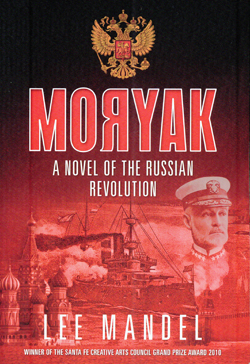Lee Mandel, Moryak: A Novel of the Russian Revolution, Glagoslav Publications, ISBN 978-17-826704-6-9, 398 pages, No cover price listed.
By Donald H. Harrison

 SAN DIEGO — It is a good thing that this book is labeled as a novel in its sub-title. Otherwise, in this age of public disclosures about government machinations and spying, we might be tempted to believe that the events that author Mandel imagines actually happened. And if we believed that, we would find ourselves again wondering if anyone in Washington cares about the ideals upon which we raised.
SAN DIEGO — It is a good thing that this book is labeled as a novel in its sub-title. Otherwise, in this age of public disclosures about government machinations and spying, we might be tempted to believe that the events that author Mandel imagines actually happened. And if we believed that, we would find ourselves again wondering if anyone in Washington cares about the ideals upon which we raised.
Mandel likes to write about the military and about U.S. presidents, and in this novel he brings together both his interests. Stephen Morrison (né Lev Kambotchnik) is the adopted son of a U.S. Congressman and graduates from the Naval Academy at Annapolis standing second in his class, notwithstanding the hazing and prejudice he endures because he is a Jew. Handsome, fit, brave, politically connected, capable of mastering new information quickly, able to speak both English and his native Russian flawlessly, and tough, very tough, Morrison’s rise through the Navy brings him to the attention of U.S. President Theodore Roosevelt.
Wanting nothing more than to serve his adopted country–and to win its approval–Morrison unhesitatingly volunteers when Roosevelt offers a top-secret assignment doomed to failure: he is to assassinate Tsar Alexander III of Russia, in order to enable the monarch’s successors to conclude a treaty of peace with Japan. If he is caught, Roosevelt warns, the U.S. will deny any relationship to him.
Starved for acceptance and desirous for advancement, Morrison accepts the foolhardy assignment and ends up in a Russian prison, waiting for his death sentence to be carried out. But a warden rewards him, executing another man instead and sending Morrison to a labor camp under that man’s identity. Morrison becomes known as Moryak, and is believed to be the man who seized control of a Russian battleship and ordered the execution of all its officers.
As the book continues, we watch as Morrison ruthlessly takes over the substructure of leadership at the prison, further enhancing the reputation of this Moryak. The notoriety brings him to the attention of the Bolshevik leadership.
When Morrison gets out of prison, the Bolsheviks are not the only ones who want to recruit him. The U.S. government also becomes aware that he is still alive. It wants to reactivate this remarkable Navy officer in a new cause.
Mandel has created a very readable tale. Even though his story was fiction, it was based on considerable historical research. I felt that I had learned something about members of Russia’s Romanov dynasty and the Communist leaders who replaced them. Because the book is a novel, however, I’m not certain which parts were true, and which were fiction. I certainly wouldn’t cite this book as source material for a historical essay on the Russian Revolution. But I will recommend it as an interesting, and at times exciting, read about a violent period in world history.
*
Harrison is editor of San Diego Jewish World. He may be contacted via donald.harrison@sdjewishworld.com